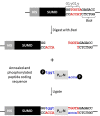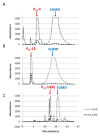Recombinant production of self-assembling β-structured peptides using SUMO as a fusion partner
- PMID: 22759375
- PMCID: PMC3512519
- DOI: 10.1186/1475-2859-11-92
Recombinant production of self-assembling β-structured peptides using SUMO as a fusion partner
Abstract
Background: Self-assembling peptides that form nanostructured hydrogels are important biomaterials for tissue engineering scaffolds. The P₁₁-family of peptides includes, P₁₁-4 (QQRFEWEFEQQ) and the complementary peptides P₁₁-13 (EQEFEWEFEQE) and P₁₁-14 (QQOrnFOrnWOrnFOrnQQ). These form self-supporting hydrogels under physiological conditions (pH 7.4, 140 mM NaCl) either alone (P₁₁-4) or when mixed (P₁₁-13 and P₁₁-14). We report a SUMO-peptide expression strategy suitable for allowing release of native sequence peptide by SUMO protease cleavage.
Results: We have expressed SUMO-peptide fusion proteins from pET vectors by using autoinduction methods. Immobilised metal affinity chromatography was used to purify the fusion protein, followed by SUMO protease cleavage in water to release the peptides, which were recovered by reverse phase HPLC. The peptide samples were analysed by electrospray mass spectrometry and self-assembly was followed by circular dichroism and transmission electron microscopy.
Conclusions: The fusion proteins were produced in high yields and the β-structured peptides were efficiently released by SUMO protease resulting in peptides with no additional amino acid residues and with recoveries of 46% to 99%. The peptides behaved essentially the same as chemically synthesised and previously characterised recombinant peptides in self-assembly and biophysical assays.
Figures




Similar articles
-
Optimization of the recombinant production and purification of a self-assembling peptide in Escherichia coli.Microb Cell Fact. 2014 Dec 31;13:178. doi: 10.1186/s12934-014-0178-0. Microb Cell Fact. 2014. PMID: 25551787 Free PMC article.
-
Production of recombinant peptides as fusions with SUMO.Protein Expr Purif. 2011 Aug;78(2):113-9. doi: 10.1016/j.pep.2011.04.015. Epub 2011 May 10. Protein Expr Purif. 2011. PMID: 21586326
-
Recombinant self-assembling peptides as biomaterials for tissue engineering.Biomaterials. 2010 Dec;31(36):9395-405. doi: 10.1016/j.biomaterials.2010.08.051. Epub 2010 Oct 8. Biomaterials. 2010. PMID: 20932572 Free PMC article.
-
Strategies for the expression of SUMO-modified target proteins in Escherichia coli.Methods Mol Biol. 2009;497:211-21. doi: 10.1007/978-1-59745-566-4_14. Methods Mol Biol. 2009. PMID: 19107420 Review.
-
Smart self-assembled hybrid hydrogel biomaterials.Angew Chem Int Ed Engl. 2012 Jul 23;51(30):7396-417. doi: 10.1002/anie.201201040. Angew Chem Int Ed Engl. 2012. PMID: 22806947 Free PMC article. Review.
Cited by
-
Soluble Production of Human Recombinant VEGF-A121 by Using SUMO Fusion Technology in Escherichia coli.Mol Biotechnol. 2018 Aug;60(8):585-594. doi: 10.1007/s12033-018-0094-3. Mol Biotechnol. 2018. PMID: 29943150
-
Injectable self-assembled GDF5-containing dipeptide hydrogels for enhanced tendon repair.Mater Today Bio. 2024 Apr 3;26:101046. doi: 10.1016/j.mtbio.2024.101046. eCollection 2024 Jun. Mater Today Bio. 2024. PMID: 38600922 Free PMC article.
-
Supramolecular Hydrogelators and Hydrogels: From Soft Matter to Molecular Biomaterials.Chem Rev. 2015 Dec 23;115(24):13165-307. doi: 10.1021/acs.chemrev.5b00299. Epub 2015 Dec 8. Chem Rev. 2015. PMID: 26646318 Free PMC article. Review.
-
Multiscale assembly for tissue engineering and regenerative medicine.Trends Biotechnol. 2015 May;33(5):269-279. doi: 10.1016/j.tibtech.2015.02.003. Epub 2015 Mar 18. Trends Biotechnol. 2015. PMID: 25796488 Free PMC article. Review.
-
Optimization of the recombinant production and purification of a self-assembling peptide in Escherichia coli.Microb Cell Fact. 2014 Dec 31;13:178. doi: 10.1186/s12934-014-0178-0. Microb Cell Fact. 2014. PMID: 25551787 Free PMC article.
References
-
- Bell CJ, Carrick LM, Katta J, Jin Z, Ingham E, Aggeli A, Boden N, Waigh TA, Fisher J. Self-assembling peptides as injectable lubricants for osteoarthritis. J Biomed Mater Res A. 2006;78:236–246. - PubMed
-
- Firth A, Aggeli A, Burke JL, Yang XB, Kirkham J. Biomimetic self-assembling peptides as injectable scaffolds for hard tissue engineering. Nanomedicine. 2006;1:189–199. - PubMed
Publication types
MeSH terms
Substances
Grants and funding
LinkOut - more resources
Full Text Sources
Other Literature Sources

